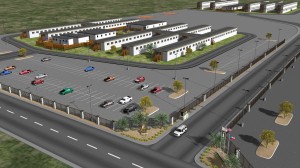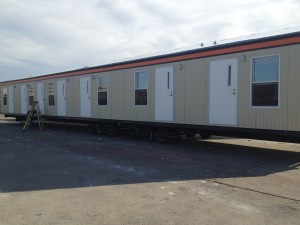Living Large, Temporary Style
It goes by a number of names: temporary housing, workforce housing, “man camps,” lodges, worker accommodations—but by whatever name, these developments are making an impact in the Permian, as they have in all booming oil and gas plays.
ODESSA—It’s quiet here in the dining hall of Goliath Industries’ pristine, barely completed workforce housing facility out on West Bell Street, where Ed Parker, Goliath’s regional sales manager, sits across the table and answers questions about his company’s line of work. Quiet, yes, but only because we’re in that afternoon lull between rushes. Had we been visiting here last night, the place would have been bustling, the room would be redolent of prime rib and double-baked potatoes, and the adjoining rec room would have pealed forth with the occasional laugh, the sounds of CNN, and the crack of billiard balls.
But occupants of this new place catch their rides early in the morning, and it’s not until dinnertime—and sometimes way past—that most are back to hit the 24-hours-a-day dining hall.
Goliath, one of the nation’s biggest builders of workforce housing, arrived here earlier this year. Their aim was not this facility—a relatively small “camp” that they put together in four weeks for Weatherford International. This was a single-client project. Goliath’s real aim is a 52-acre project just a few miles from here. They’re erecting a facility to house 1,250 oilfield workers. Apart from the cost of the land—the parcel is already purchased—Goliath could be putting as much as $10 million into it, in improvements.
“Our intent is to make it upscale,” Parker said. “We’re talking about wrought-iron fence around it. The units themselves
will be single-occupancy, with private baths. Two hot meals a day, plus a sack lunch, complete catering services, housekeeping services, bussing [shuttle] services. The food is great—we fly our chefs in from all over the country.”
Goliath is not alone as a provider of this sort of service. Called “man camps” by some, and “temporary workforce housing” by others, these compounds began springing up in remote locales like the Bakken shale play in North Dakota. And while there have always been companies that have provided wellsite housing for workers, the practice of erecting these sorts of accommodations for larger groups is relatively new. Newest of all is the path Goliath has undertaken—going into a metro area and creating an “open” camp… a camp that is not necessarily controlled by a single energy firm, but rather may house workers from multiple companies.
The Midland-Odessa area already has attracted interest from Target Logistics, a national developer of temporary housing, and Black Gold, which is ahead of both Target and Goliath in getting a larger camp out of the ground.
These are some of the companies building “camps.” Further out in the hinterlands, nearer the actual wellsites, the players are companies like HB Rentals and Stallion Oilfield Services Ltd., both of which provide wheel-mounted and skid-mounted housing units for workers.
Altogether, these specialty builders fill a niche that is growing fast. Guy Andrews, Director of Economic Development for the Odessa Chamber of Commerce, said that workforce housing is one of his office’s priorities.
“We’re really hurting in terms of getting sufficient housing for the workers right now, especially those in the service industry sector,” Andrews said. “We have 100 percent occupancy in apartments, 100 percent occupancy in motels. We have the highest motel rates in the state of Texas right now. We need some type of temporary housing, if for no other reason than to get some relief for those apartments and motels.”
The energy boom in West Texas and southeastern New Mexico has made the region one of the fastest-growing and most resource-challenged areas in the nation.
“I believe the average hotel room rate is $250 a night—if you can get one,” Andrews said. “I’ve heard of people standing in line at a hotel hoping to get a room if there is a cancellation. When one comes up, the quoted rate might be $300. Someone else in line might say, ‘I’ll give you $350 for it.’ I’ve heard of rooms going for as much as $500. It’s an incredible situation—the best of times and the worst of times. We have a workforce shortage, but we can’t get workers because we have a housing shortage.”
Andrews said that one appealing aspect of the temporary housing angle is the fact that it does not potentially contribute to an overbuilt situation. If the boom should disappear, temporary structures—unlike permanent apartment complexes—can simply be picked up and moved to some other part of the country.
And that is a good thing. “We’re in a housing- and apartment-building boom out here as well,” Andrews said. I’m aware of nine hotels that are being built, and three apartment complexes for sure. I know there are several others in the planning stages.”
Yet Andrews, like a growing number of civic officials and private businesspeople, has a sense that the current boom might not be as short-lived as some past booms have been.
“I don’t think there has to be a bust,” Andrews said. “This one should be sustainable, with the players that are out there. And even if drilling gets curtailed a certain amount, you still have to service the [wells] that are already drilled. When the oil price drops, the first thing that drops back is the drilling, but even at that, our growth was the top in the nation over the past year. We are rated number one or two by some magazines for job growth and economic growth, and even if we grow just one or two percent, that is better than most places. Besides, as hectic as things are now, we might even welcome a little cutback if it allows [other] things to catch back up.”
For all of these reasons, Andrews said, there is a need for the temporary worker housing camps. “And the faster they can get them up, the better.”
The activity continues apace. “I’ve been contacted by Canadian companies. By a Tulsa company. Almost every week I’m contacted by somebody who wants to do some temporary housing here. There’s some developer from Houston who has a plan they want to try. The type varies from one developer to the next. Some are relatively ‘Spartan,’ some are much nicer. Some are not so dormitory-style—they might have two or three units together. There are even some with executive lodgings.”
Andrews said that what his office hopes to see are more projects that will open to a clientele that is not exclusively corporate. “We’d like to see projects that are open to individuals [as customers],” Andrews said. “So many people can’t find a place to stay. People get tired of it, and the rates for apartments just keep rising astronomically.”
Andrews wasn’t aware of Goliath Industries’ projections of 1,250 beds, and he  remarked that the biggest proposal with which he was familiar was one from Target Logistics, which had discussed 419 units. “They also have an option on an additional property,” Andrews said. “Schlumberger has built some work camps that we weren’t even aware of. There are a lot of projects we’ve not been made aware of. Just the stuff that comes through our door—that alone is staggering. Chevron last year had to buy 10,000 motel room nights [in the Midland-Odessa area] so they are building a hotel. A lot of these oil companies rent entire floors of hotels, so these work camps will relieve a lot of that.”
remarked that the biggest proposal with which he was familiar was one from Target Logistics, which had discussed 419 units. “They also have an option on an additional property,” Andrews said. “Schlumberger has built some work camps that we weren’t even aware of. There are a lot of projects we’ve not been made aware of. Just the stuff that comes through our door—that alone is staggering. Chevron last year had to buy 10,000 motel room nights [in the Midland-Odessa area] so they are building a hotel. A lot of these oil companies rent entire floors of hotels, so these work camps will relieve a lot of that.”
A quick drive-by of the Goliath property confirms that it is right in town, only a very few miles from the center of town, but further checking reveals that it sits not on city land but on county land. It is merely surrounded by city land. That explains why the Goliath project can go up here, but Midland officials, meanwhile, say that “man camps” are not allowed inside the Midland city limits.
At Midland, Steve Thorpe, Building Official for the City of Midland, confirmed that there are no man camps going up in the city itself, though he said he was aware of projects in the outlying areas.
“Anything that sits on a piece of property for more than 180 days is not considered ‘temporary,’ not by the city code,” Thorpe said. “And if it is permanent, then it must meet the code for permanent structures. So far, no one has come into the city with a project like that [a temporary housing project] because they don’t want to meet those requirements.”
The building code takes into account safety issues, zoning requirements, and other such matters, Thorpe said.
But his office is not against the idea of more housing, especially in these times of greatest need.
“All [new] housing helps us, whether it’s in or out of Midland,” he said. “We are working with developers every day to come up with solutions. Two apartment complexes have been permitted [recently]. Two more are going through planning and zoning steps. Four hotels have gone under construction, and there are discussions on a couple more. We have had discussions with a couple of people interested in developing manufactured home communities. And there have been some preliminary discussion of developing some buildings downtown into housing.”
 Thorpe said he did not think that the current boom necessarily had to turn into a bust, and he said he bases that on the idea that this boom is based on technology first, and demand second. “And that’s a good sign,” he said.
Thorpe said he did not think that the current boom necessarily had to turn into a bust, and he said he bases that on the idea that this boom is based on technology first, and demand second. “And that’s a good sign,” he said.
Target Logistics, which has been in discussions about its proposed Permian Basin Lodge, targeted for the Midland/Odessa area, already has a lodge in the Eagle Ford area and at Carizzo Springs. The company is also considering entry into the Big Lake and Pecos markets.
Both Eagle Ford and Carizzo have been successful ventures, according to Randy Pruett, spokesperson for the firm. In the Eagle Ford, the company has 302 beds.
The company has a total of 14 lodges through North America, totalling more than 5,300 beds. The units are generally private rooms with baths, and the bedroom area features what Target calls a hyphenator sleep system. The amenities are upscale and include high-thread count sheets and pillow cases and oversized towels. Each unit has a flat screen satellite television and DVD player. They also offer housekeeping services and free self-service laundries, as well as a game and recreation room, and a gym and fitness center. Each lodge as an internet cafe and there is free site-wide internet connectivity.
Pruett said that civic officials in the Midland-Odessa area had been very welcoming. “That’s something I can’t stress enough,” he said. “And we want to be likewise. We have a very strong commitment to the communities in which we operate and we like to give back or otherwise make contributions to local social or educational programs. We adhere to a strict waste reduction and pollution reduction program. We subscribe to the ethical standards of the communities.”
Pruett said he thinks that the development of temporary housing projects help keep local apartment and lodging rental rates “from going sky high.”
That sentiment is shared by many who develop such projects, and by the local leaders who welcome them.
HB Rentals, a division of Superior Energy, has been actively filling temporary workforce housing needs in the Permian for several years. Mike Roper, HB Rental’s regional sales manager for Texas and New Mexico, says that the company has houses on a number of work sites between Midland and Carlsbad, N.M.
“We work for about every operator out there,” Roper said. “Some of our houses are wheeled trailer houses and some are skid-mounted houses. We provide onshore and offshore living accommodations all over the world.”
HB Rentals’ units are mobile, being transferred from drilling location to drilling location. The company also installs generators, VSAT satellite systems, water lines, sewer lines, and other infrastructure. They maintain a full service yard in Midland and another in Carlsbad. “We are very, very busy out there,” Roper said.
His associate, Tim Murphy, agreed that Midland-Odessa is a strong market for them right now.
“For a while now, the rig count has been high,” said Murphy, the company’s technical sales and marketing manager. “There’s a rig everywhere you look. There’s just such an influx of companies coming into the area, and that requires a lot of living quarters. Whenever you even just go there to a trade show, you can hardly get a motel room.”
Stallion Oilfield Services, Ltd., like HB Rentals, concentrates its efforts at the work sites themselves.
Allen Hebert, vice president for operation support at Stallion, said the company provides rig-side accommodations with water systems, satellite communications, and of course wheel-mounted and skid-mounted manufactured housing.
“We’re in all the major plays in the United States,” Hebert said. “We have about 200 units going in the Permian.”
Back in Odessa, in the dining hall at the Goliath Industries facility, Ed Parker remarked on what he sees as a transitional step.
“It’s been very interesting in that we [traditionally] supply remote workforce housing, and pretty much all our other camps are that. This area is unique in that it is not remote. It’s right outside a city with a population of 100,000 and 20 miles from another one. That’s unique in that we have competition from the hotel industry.
“Also, this area seems to be on the cusp of some big changes. Currently, the local oil companies have pretty well saturated the market, in terms of hiring local people—people who have housing locally. Now they’re bringing in people from Idaho or Wyoming, places like that. Once they do, they will need this form of housing. We think this area has tremendous potential for growth… not just for the oil industry, but for other industries as well. We heard that the Summit Energy plant that will go in west of here will need 2,500 workers. Those individuals will need housing too.
“You go up to Williston, North Dakota, up to the Wal-Mart up there, and you find that most of the goods are in boxes sitting in the aisles. They are not sitting on the shelves. You have to dig through the boxes to find what you want. They don’t have enough manpower to keep it stocked.
Having adequate housing is essential to having adequate manpower, Parker said. “But we think this area is in for a long run. The indications are that this boom will go on for a good many years.”













